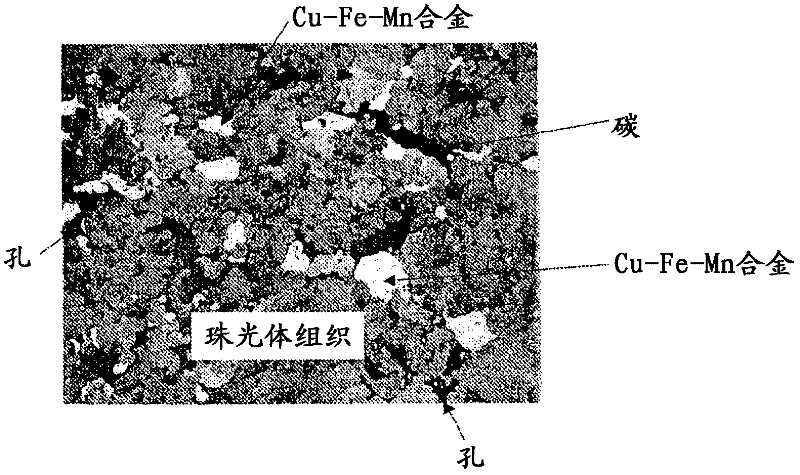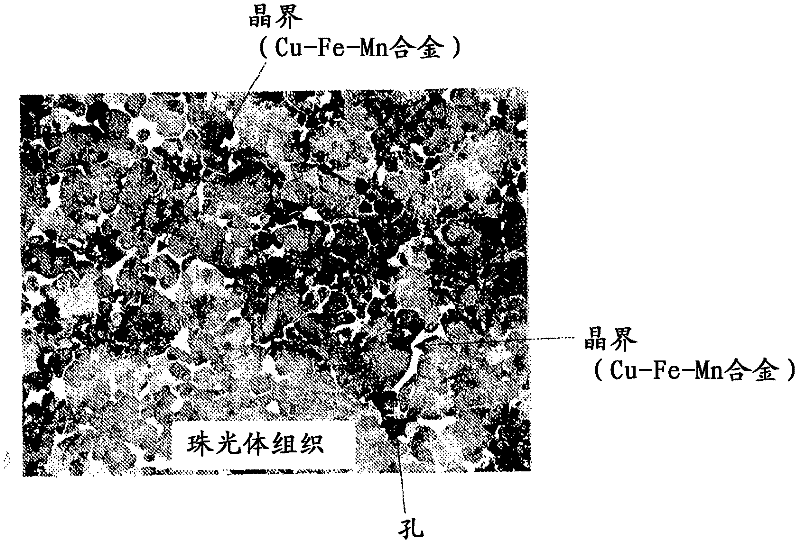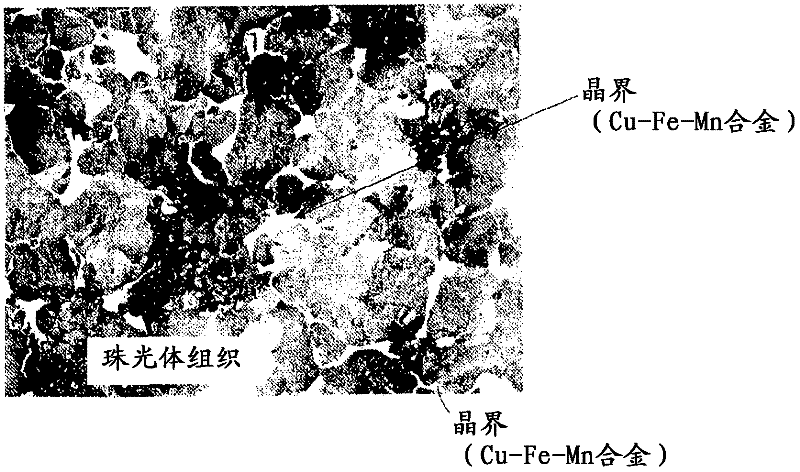Iron-based sintered sliding member, and process for production thereof
A technology of sliding parts and manufacturing methods, applied in the directions of bearing elements, mechanical equipment, shafts and bearings, etc., to achieve the effect of improving running-in and sliding characteristics
- Summary
- Abstract
- Description
- Claims
- Application Information
AI Technical Summary
Problems solved by technology
Method used
Image
Examples
Embodiment 1
[0057] Copper containing 90.5% by mass of copper, 4.1% by mass of iron, and 5.4% by mass of manganese and having an average particle size of 75 μm is mixed with atomized iron powder with an average particle size of 70 μm ("Atmel 300M" manufactured by Kobe Steel Co., Ltd.) - 12% by mass of iron-manganese alloy powder (manufactured by Fukuda Metal Foil Industry Co., Ltd.) and 3% by mass of natural graphite powder (manufactured by Nippon Graphite Co., Ltd.) with an average particle diameter of 40 μm as a carbon component, mixed in a V-shaped mixer for 20 minutes to obtain mixing Powder (copper component 10.86 mass%, manganese component 0.65 mass%, iron component 85.49 mass%, carbon component 3 mass%). Next, fill the mixed powder into a mold to carry out a molding pressure of 5 tons / cm 2 Shaping is performed to obtain a square compact.
[0058] The rectangular compact was placed in a heating furnace adjusted to a hydrogen atmosphere, solid-phase sintered at a temperature of 1000°...
Embodiment 2
[0060] Obtain the same mixed powder (10.86 mass % of copper component, 0.65 mass % of manganese component, 85.49 mass % of iron component, 3 mass % of carbon component) as above-mentioned Example 1, this mixed powder is packed in the mold, with molding pressure 5 tons / cm 2 Shaping is performed to obtain a square compact. The rectangular compact was placed in a heating furnace adjusted to a hydrogen atmosphere, liquid-phase sintered at a temperature of 1100° C. for 60 minutes, and then taken out from the heating furnace to obtain a square iron-based sintered material. The iron-based sintered material was machined to obtain an iron-based sintered sliding part having a size of 30 mm on one side and 5 mm in thickness. The density of this iron-based sintered sliding part is 6.7g / cm 3 , organized as figure 2 , image 3 As shown, there is a structure in which pearlite and part of ferrite coexist, and no free cementite is formed in the structure, and it is confirmed that the gra...
Embodiment 3
[0062] Copper-iron-manganese alloy powder with an average particle diameter of 75 μm containing 90.5% by mass of copper, 4.1% by mass of iron, and 5.4% by mass of manganese was blended with atomized iron powder with an average particle diameter of 70 μm (same as in Example 1 above). (Same as above-mentioned Example 1) 10% by mass and 3% by mass of natural graphite powder (same as above-mentioned Example 1) with an average particle diameter of 40 μm as a carbon component, mixed in a V-shaped mixer for 20 minutes to obtain a mixed powder (copper component 9.05% by mass, 0.54% by mass of the manganese component, 87.41% by mass of the iron component, and 3% by mass of the carbon component). Next, the mixed powder is filled into the mold, with a molding pressure of 5 tons / cm 2 Forming is performed to obtain a cylindrical compact.
[0063] The cylindrical compact was placed in a heating furnace adjusted to a hydrogen atmosphere, liquid-phase sintered at a temperature of 1100° C. fo...
PUM
| Property | Measurement | Unit |
|---|---|---|
| density | aaaaa | aaaaa |
| density | aaaaa | aaaaa |
| length | aaaaa | aaaaa |
Abstract
Description
Claims
Application Information
 Login to View More
Login to View More - R&D
- Intellectual Property
- Life Sciences
- Materials
- Tech Scout
- Unparalleled Data Quality
- Higher Quality Content
- 60% Fewer Hallucinations
Browse by: Latest US Patents, China's latest patents, Technical Efficacy Thesaurus, Application Domain, Technology Topic, Popular Technical Reports.
© 2025 PatSnap. All rights reserved.Legal|Privacy policy|Modern Slavery Act Transparency Statement|Sitemap|About US| Contact US: help@patsnap.com



